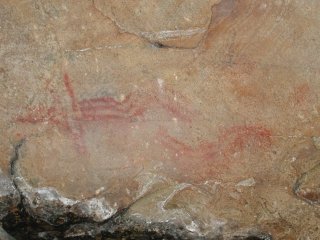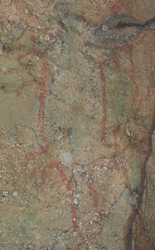The Petit Jean Painted Rock Art Style By Michelle Berg Vogel Introduction This article discusses the concept of style in rock art studies, and provides an updated definition of the Petit Jean Painted style of rock art in Arkansas.
In 1978 Gayle Fritz and Robert Ray of the Arkansas Archeological Survey began the first detailed study of rock art sites in Arkansas. Their research resulted in a National Register of Historic Places thematic nomination of 28 rock art sites throughout the state, including 11 sites in Petit Jean State Park. They also defined a new rock art style called Petit Jean Painted. Fritz and Ray describe this style as follows: Design elements were usually executed using red iron oxide paint. Geometric forms, both rectilinear and curvilinear, predominate but human and animal figures are also present. While a few sites contain relatively extensive painted areas, it is common to find single design elements, or very small groupings of designs in relative isolation on shelter walls and ceilings (1982: 252). The data more recently collected by the Arkansas Rock Art Project allow a closer consideration of the stylistic characteristics of rock art in the central Arkansas River Valley, and a reexamination of the Petit Jean Painted style definition. Style in Rock Art Analysis Archeologists use the concept of style to systematically organize information on variations in artworks and decorated material objects, such as basketry or ceramics. Regional patterns of stylistic variability may reveal changing preferences within or between distinct groups or from one time period to the next. Polly Schaafsma has suggested that “recognition of rock art styles is basic to the ordering of data concerning rock art” (Schaafsma 1980:6). James D. Keyser offers this definition of a rock art style: [A] group of recurring motifs or designs (e.g., rayed arc, human figure) portrayed in typical forms (e.g., alternate red and white rays, stickman), which produce basic recognizable types of figures. Usually these various figures are associated with one another in structured relationships, leading to an overall distinctiveness of expression (Keyser 1992:16). This definition guides our efforts to define (or refine) a particular style. This basic information includes:
A specific configuration of these variables will lend an overall distinctiveness of expression to all the images that can be included within a defined style. New Data on the Petit Jean Painted Style New data collected during Arkansas Rock Art Project fieldwork from 2000 to 2003 allow a reexamination of this style definition.
Our team examined rock art at a number of sites that Fritz and Ray were unable to visit, and recorded many previously unobserved motifs and elements. We find that subject matter generally falls into one of several basic categories: representational figures of animals, plants, humans, crafted objects, and celestial objects; and nonrepresentational geometric or abstract figures. The human figure category includes hand prints and foot prints. Likewise, we include animal tracks in the same category with animal figures. Complete plants (such as the fiddlehead fern from Indian Cave) are usually illustrated, though we suspect some images represent plant parts such as seed pods. Crafted objects represent artifacts, for example, weapons or headdresses. Celestial objects are stars, moons, and sunbursts. The geometric category includes any nonrepresentational image that can be described according to a common, simple shape (e.g., squares, rectangles, spirals). Abstracts are images that we cannot assign to one of the other categories but which are too complex to describe in terms of a simple shape. Image forms include solid, outlined, and line (or stick-figure) drawings. Solid forms are entirely filled in with pigment. Outline forms consist of a traced shape that is not filled in. Line drawings reduce forms to stick-figure representations. Some forms are naturalistic; that is, they depict their subject matter in “a reasonably realistic or natural manner" (Keyser 1992: 16). Others are stylized according to some artistic convention, but nevertheless are recognizable. Under form we also include the techniques used to make the rock art. The Petit Jean Painted style consists of pictographs rendered with red iron oxide pigment, usually by finger-painting.
So far we have studied the relationships among Petit Jean Painted images only in general terms. Many images exist as solitary elements, either as the lone image identified at a site, or spatially isolated from other images. Juxtaposed images appear to be grouped together in deliberate arrangements called panels, yet without any obvious narrative connection. In some panels, the images also have an integrated relationship; they are near each other and also seem to be interacting. An example is the fish trap and paddlefish panel at Rockhouse Cave. Also relevant are the patterns of arrangement of images within panels; for example, they may be linear or scattered. All these variations occur as part of the Petit Jean Painted style. Summary The recent fieldwork undertaken by the Arkansas Rock Art Project allows us to expand upon the original Fritz and Ray definition of the Petit Jean Painted rock art style. Characteristics of this style now include:
Rock art surveys conducted on other central Arkansas River Valley mountains, including Carrion Crow, Dardanelle, and Manitou mountains, indicate that these characteristics fit the stylistic features of images found there as well. Additional studies are needed to determine whether “micro-stylistic” variations can be associated with rock art found on separate mountains or mountain groups in the central Arkansas River Valley. Acknowledgements This research was conducted in part through an Arkansas Department of Parks and Tourism project with funding through a grant from the Arkansas Natural and Cultural Resources Council. The staff at Petit Jean State Park, especially Wally Scherrey and Steve Dunlap, were very helpful in providing access to the sites. Ben Swadley at the Plantation Agriculture Museum has worked tirelessly to help conserve the rock art at Petit Jean and has been very supportive of this project. Field and lab work were conducted through the Arkansas Archeological Survey as part of a grant from the Arkansas Humanities Council and the the Arkansas Historic Preservation Program. Jerry Hilliard, Dr. George Sabo III, Mike Evans, Jared Pebworth, Larry Porter, Debbie Weddle, Deborah Sabo, and Jami Lockhart were part of the Survey team working on this project. Gregory Vogel also helped with fieldwork and any number of unnamed tasks. References Cited Fritz, Gayle J. and Robert Ray Keyser, James D. Schaafsma, Polly |
| Home | Quick Facts | Interpretations | Articles | Technical Papers | Resources | Database | Just For Kids | Picture Gallery | Buy the Book! |
|
Last Updated: May 19, 2008 at 3:48:59 PM Central Time
|



